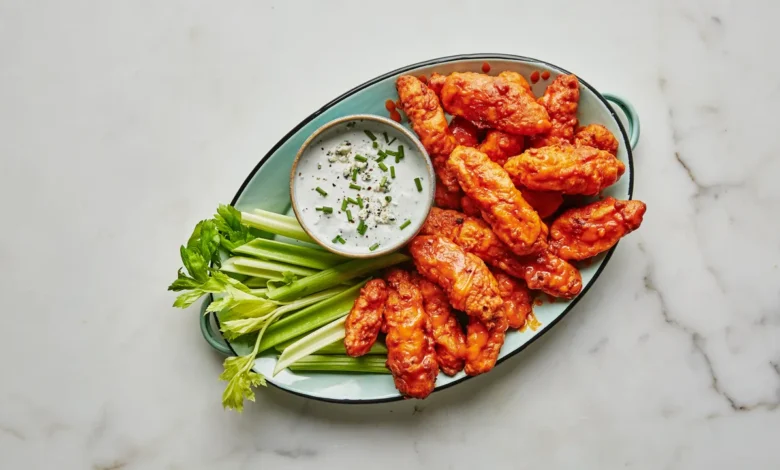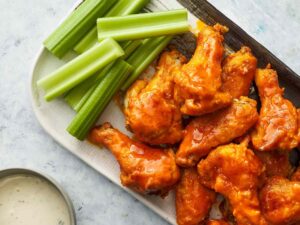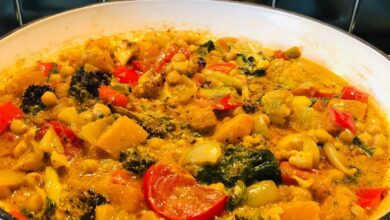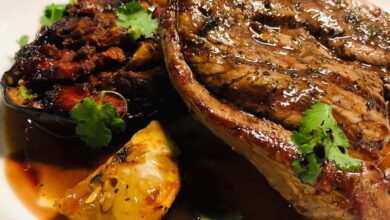Buffalo wings Recipe
Buffalo wings Recipe

Buffalo wings Recipe Introduction:
Buffalo wings are a beloved American classic that originated in Buffalo, New York, in the 1960s. These crispy, flavorful chicken wings are coated in a spicy, tangy sauce and are often served with cooling celery sticks and creamy blue cheese or ranch dressing. They’re a staple at sports events, parties, and casual gatherings due to their irresistible flavor and finger-licking goodness.
The beauty of Buffalo wings lies in their simplicity and the balance of heat and tanginess from the sauce. Typically made with chicken wings that are deep-fried until crispy, they are then tossed in a sauce made from hot sauce, butter, and other seasonings. The result is a dish that’s both spicy and buttery, with a satisfying crunch.

Buffalo wings Recipe Ingredients:
For the Wings:
- 2 pounds chicken wings – Make sure they are thawed and patted dry to ensure crispiness.
- 1/2 cup all-purpose flour – For coating the wings to help achieve a crispy texture.
- 1 teaspoon paprika – Adds a mild smokiness and color.
- 1 teaspoon garlic powder – Enhances the overall flavor.
- 1/2 teaspoon salt – For seasoning.
- 1/2 teaspoon black pepper – Adds a touch of heat and flavor.
- Oil – For frying (vegetable oil or canola oil works best).
For the Sauce:
- 1/2 cup hot sauce – Frank’s RedHot is a popular choice for authenticity, but you can use your preferred brand.
- 1/4 cup unsalted butter – Adds richness and helps to balance the heat of the hot sauce.
- Optional: 1 tablespoon honey – For a touch of sweetness if you like a sweeter sauce.
For Serving:
- Celery sticks – Traditional accompaniment to provide a crisp and refreshing contrast to the spicy wings.
- Blue cheese or ranch dressing – For dipping; blue cheese is the classic choice, but ranch is also popular.
Optional Ingredients for Extra Flavor:
- 1/2 teaspoon cayenne pepper – For an extra kick of heat.
- 1/2 teaspoon onion powder – To add depth to the seasoning mix.
Buffalo wings Recipe Ingredient Tips:
Chicken Wings:
- Buy Fresh or Frozen: Fresh chicken wings are ideal, but frozen wings are convenient. Just make sure they’re fully thawed before cooking.
- Separate the Wing Sections: If your wings are whole, you’ll need to cut them into drumettes and flats. The wing tip can be discarded or saved for making stock.
Flour Coating:
- Use Cornstarch for Extra Crispiness: For an even crispier texture, you can replace half of the flour with cornstarch.
- Season the Flour: Enhance the flavor by adding additional seasonings to the flour, such as paprika, onion powder, or cayenne pepper.
Hot Sauce:
- Choose the Right Hot Sauce: Frank’s RedHot is a classic choice for authenticity, but you can experiment with other brands or homemade sauces to suit your taste.
- Adjust Heat Levels: If you prefer a milder sauce, reduce the amount of hot sauce or add more butter to balance the heat.
Butter:
- Use Unsalted Butter: Unsalted butter allows you to control the saltiness of the sauce. You can always add salt to taste.
- Melt Butter Gently: Melt the butter over low heat to avoid burning it, then mix in the hot sauce to ensure a smooth, well-combined sauce.
Optional Sweetener:
- Add Honey or Maple Syrup: If you prefer a sweeter sauce, honey or maple syrup can add a pleasant contrast to the spiciness. Start with a small amount and adjust to taste.
Oil for Frying:
- Use High-Smoke Point Oil: Vegetable oil, canola oil, or peanut oil are ideal because they can withstand high temperatures without burning.
- Maintain the Right Temperature: Use a thermometer to ensure the oil stays at 350°F (175°C) for consistent frying results. If the temperature drops too low, the wings will become greasy instead of crispy.
Serving Suggestions:
- Chill Wings After Frying: For extra crispy wings, allow them to rest on a wire rack for a few minutes after frying to let any excess oil drain off.
- Serve Immediately: Buffalo wings are best enjoyed hot and fresh. Serve them immediately after tossing in the sauce for optimal texture and flavor.
Additional Tips:
- Double Frying: For extra crispiness, you can fry the wings twice. Fry them initially at a lower temperature (around 325°F or 165°C), let them cool, and then fry again at 375°F (190°C) for a few minutes.
- Marinate Before Frying: Marinate the wings in a mixture of spices and buttermilk for several hours or overnight for added flavor and tenderness.
Buffalo wings Recipe Equipment Needed:
- Deep Fryer or Large Pot:
- Deep Fryer: Provides consistent temperature control for frying.
- Large Pot: If using a pot, make sure it’s deep enough to hold the oil and wings comfortably. A heavy-bottomed pot helps maintain even heat.
- Thermometer:
- Cooking Thermometer: Essential for checking the oil temperature (350°F or 175°C) and ensuring that your wings are cooked to a safe internal temperature (165°F or 74°C).
- Slotted Spoon or Spider Strainer:
- Slotted Spoon: Useful for removing the wings from the hot oil and draining them.
- Spider Strainer: A wire mesh tool that allows oil to drain away while keeping the wings secure.
- Wire Rack:
- Wire Rack: Set over a baking sheet or plate to drain excess oil from the wings after frying. This helps them stay crispy.
- Mixing Bowls:
- Large Bowl: For tossing the wings with the flour mixture before frying.
- Smaller Bowl: For mixing the hot sauce and melted butter.
- Tongs or Kitchen Tongs:
- Tongs: Useful for handling and turning the wings in the fryer or pot.
- Paper Towels:
- Paper Towels: For blotting excess oil from the wings after frying.
- Saucepan:
- Saucepan: For melting the butter and mixing with the hot sauce to make the Buffalo sauce.
- Serving Platter:
- Platter or Plate: For serving the wings. It’s often a good idea to line it with parchment paper or a clean kitchen towel to catch any extra grease.
- Measuring Cups and Spoons:
- Measuring Tools: For accurately measuring the ingredients for the flour coating and sauce.
Optional Equipment:
- Food Processor or Blender:
- Food Processor: For making homemade hot sauce or if you want to blend ingredients for a smoother sauce.
- Pasta Strainer:
- Strainer: Can be used in place of a slotted spoon or spider strainer to drain the wings.
- Basting Brush:
- Brush: For applying a light coating of sauce to the wings if you prefer a thicker, more even layer.
Buffalo wings Recipe Step-by-Step Instructions:
- Prepare the Wings:
- 1.1. Rinse the chicken wings under cold water and pat them dry thoroughly with paper towels. This helps ensure they become crispy.
- 1.2. If the wings are whole, cut them into drumettes and flats. Discard the wing tips or save them for making stock.
- Coat the Wings:
- 2.1. In a large mixing bowl, combine the flour, paprika, garlic powder, salt, and black pepper.
- 2.2. Toss the chicken wings in the flour mixture until they are evenly coated. Shake off any excess flour.
- Heat the Oil:
- 3.1. Pour oil into a deep fryer or large pot, filling it no more than halfway to prevent overflow.
- 3.2. Heat the oil to 350°F (175°C). Use a cooking thermometer to monitor the temperature.
- Fry the Wings:
- 4.1. Carefully add the wings to the hot oil in batches, avoiding overcrowding. Fry the wings for about 8-10 minutes, or until they are golden brown and crispy.
- 4.2. Use a slotted spoon or spider strainer to remove the wings from the oil and place them on a wire rack to drain and stay crispy. Blot with paper towels if necessary.
- Prepare the Sauce:
- 5.1. While the wings are frying, melt the butter in a saucepan over medium heat.
- 5.2. Once the butter is melted, remove the saucepan from the heat and stir in the hot sauce. If you like a touch of sweetness, mix in the honey. Adjust the seasoning to taste if needed.
- Toss the Wings:
- 6.1. Place the fried wings in a large mixing bowl.
- 6.2. Pour the hot sauce mixture over the wings and toss them until they are evenly coated.
- Serve:
- 7.1. Arrange the coated wings on a serving platter.
- 7.2. Serve immediately with celery sticks and your choice of blue cheese or ranch dressing for dipping.
Tips:
- For Extra Crispy Wings: Consider double frying the wings. Fry them at a lower temperature (around 325°F or 165°C), let them cool, and then fry again at 375°F (190°C) for a few minutes.
- Adjusting the Heat: Customize the level of heat in your sauce by adjusting the amount of hot sauce or adding more butter to tone it down.
Tips and Tricks:
For the Wings:
- Dry the Wings Thoroughly:
-
- Tip: Pat the wings dry with paper towels before coating them. Moisture on the skin can prevent the wings from getting crispy.
- Separate the Wing Sections:
-
- Tip: If your wings are whole, cut them into drumettes and flats. This allows for even cooking and easier eating.
- Marinate for Extra Flavor:
-
- Tip: Marinate the wings in a mixture of buttermilk, garlic powder, and spices for a few hours or overnight to add flavor and tenderness.
Coating and Frying:
- Season the Flour:
-
- Tip: Mix additional spices like cayenne pepper, onion powder, or dried herbs into the flour for extra flavor. Adjust the seasonings to your taste preference.
- Use Cornstarch:
-
- Tip: Substitute half of the flour with cornstarch for an even crispier coating. Cornstarch helps to create a crunchier texture.
- Maintain Oil Temperature:
-
- Tip: Keep the oil temperature consistent at 350°F (175°C) using a cooking thermometer. If the temperature drops too low, the wings will absorb more oil and become greasy. If it’s too high, the coating might burn before the wings are cooked through.
- Fry in Batches:
-
- Tip: Fry the wings in small batches to avoid overcrowding the pot or fryer. This ensures that the wings cook evenly and get crispy.
- Double Fry for Extra Crispiness:
-
- Tip: For extra crispy wings, fry them at a lower temperature (325°F or 165°C), let them cool, and then fry again at a higher temperature (375°F or 190°C) for a few minutes.
Making the Sauce:
- Adjust the Heat:
-
- Tip: Customize the heat level of the sauce by adjusting the amount of hot sauce or by adding a bit of honey or brown sugar for a sweeter sauce.
- Melt Butter Gently:
-
- Tip: Melt the butter over low heat to prevent it from burning. Combine it with the hot sauce off the heat to avoid separation.
- Mix the Sauce Thoroughly:
-
- Tip: Ensure the sauce is well-mixed before tossing it with the wings to achieve a consistent flavor.
Serving:
- Serve Immediately:
-
- Tip: Buffalo wings are best enjoyed hot and fresh. Serve them immediately after tossing in the sauce for the best texture and flavor.
- Cooling Rack for Crispiness:
-
- Tip: Place fried wings on a wire rack set over a baking sheet to allow any excess oil to drain off and to keep the wings crispy.
- Side Dishes:
-
- Tip: Serve with classic sides like celery sticks and blue cheese or ranch dressing to balance the heat and add a refreshing crunch.
- Leftovers:
-
- Tip: If you have leftover wings, reheat them in an oven or air fryer to maintain crispiness. Avoid microwaving as it can make them soggy.
Serving Suggestions:
Classic Accompaniments:
- Celery Sticks:
- Description: Crisp and refreshing, celery sticks provide a crunchy contrast to the spicy wings. They also help cool the heat and add a fresh, clean bite.
- Carrot Sticks:
- Description: Like celery, carrot sticks offer a crunchy texture and a slightly sweet flavor that pairs well with the heat of the wings.
- Dipping Sauces:
- Blue Cheese Dressing: The creamy, tangy flavor of blue cheese dressing complements the spiciness of the wings and is a traditional choice.
- Ranch Dressing: Ranch offers a milder, creamy alternative to blue cheese and is a popular option for those who prefer a less pungent flavor.
Complementary Sides:
- Potato Wedges or Fries:
- Description: Crispy, seasoned potato wedges or fries are a hearty side that pairs well with the rich flavor of Buffalo wings. You can also offer sweet potato fries for a slightly sweeter option.
- Onion Rings:
- Description: Crispy, golden-brown onion rings add a satisfying crunch and complement the wings’ flavor.
- Cornbread:
- Description: Sweet and buttery cornbread provides a comforting, slightly sweet contrast to the spicy wings.
- Macaroni and Cheese:
- Description: A creamy, cheesy mac and cheese can balance the heat of the wings and add a rich, comforting element to the meal.
Salads and Vegetables:
- Coleslaw:
- Description: A tangy, creamy coleslaw can provide a cool, crunchy contrast to the spicy wings and add a refreshing element to the meal.
- Caesar Salad:
- Description: A classic Caesar salad with crisp romaine, Parmesan cheese, croutons, and Caesar dressing offers a savory, tangy side that pairs well with the wings.
- Cucumber Salad:
- Description: A light and refreshing cucumber salad with a simple vinegar-based dressing can help balance the richness and heat of the wings.
Bread and Rolls:
- Garlic Bread:
- Description: Flavorful garlic bread or breadsticks can be a great accompaniment, perfect for soaking up any leftover sauce.
- Dinner Rolls:
- Description: Soft, buttery dinner rolls are ideal for mopping up any extra sauce and complement the meal nicely.
Drinks:
- Cold Beer:
- Description: A crisp, cold beer, especially a lager or pale ale, is a classic pairing with spicy Buffalo wings and can help cut through the heat.
- Lemonade or Iced Tea:
- Description: Refreshing non-alcoholic options like lemonade or iced tea can provide a cooling effect and complement the flavors of the wings.
- Milk or Buttermilk:
- Description: The creamy, cooling effect of milk or buttermilk can help counteract the spiciness and soothe the palate.
Presentation Tips:
- Garnish with Fresh Herbs:
- Tip: Garnish the wings with chopped fresh parsley or cilantro for a pop of color and a hint of freshness.
- Serve with a Variety of Sauces:
- Tip: Offer a selection of sauces, including mild, medium, and hot, so guests can choose their preferred level of heat.
- Use a Platter or Serving Tray:
- Tip: Arrange the wings on a large platter or serving tray for an appealing presentation, and include dipping sauces and sides around the wings.
These serving suggestions can help turn your Buffalo wings into a well-rounded and enjoyable meal, perfect for gatherings, game days, or casual dinners.
FAQs:
- How do I make Buffalo wings less spicy?
Answer: To reduce the heat of Buffalo wings, you can adjust the hot sauce used in the recipe. Start with a milder hot sauce or reduce the amount of hot sauce in the recipe. You can also add extra butter to the sauce to tone down the heat. Another option is to mix the hot sauce with a mild barbecue sauce or honey for a sweeter, less spicy flavor.
- Can I bake Buffalo wings instead of frying them?
Answer: Yes, you can bake Buffalo wings for a healthier alternative to frying. To bake them, preheat your oven to 400°F (200°C). Arrange the coated wings in a single layer on a wire rack set over a baking sheet (to allow air circulation and crispiness). Bake for 40-45 minutes, flipping halfway through, until the wings are crispy and fully cooked. After baking, toss them in the Buffalo sauce as you would with fried wings.
- How do I keep Buffalo wings crispy?
Answer: To keep Buffalo wings crispy, follow these tips:
- Dry the Wings: Ensure the wings are thoroughly dried before coating.
- Proper Frying Temperature: Maintain the oil temperature at 350°F (175°C) during frying.
- Drain Excess Oil: Place wings on a wire rack after frying to let excess oil drain off.
- Serve Immediately: Wings are best served hot and fresh to maintain their crispiness.
- Can I prepare Buffalo wings in advance?
Answer: While Buffalo wings are best enjoyed fresh, you can prepare them in advance by cooking them ahead of time. To do this, fry or bake the wings and then store them in an airtight container in the refrigerator for up to 3 days. Reheat the wings in the oven at 375°F (190°C) for about 10-15 minutes to restore crispiness before tossing them in the sauce.
- What’s the difference between Buffalo wings and regular chicken wings?
Answer: Buffalo wings are a specific style of chicken wings that are deep-fried and then coated in a spicy, tangy hot sauce, typically made from hot sauce and butter. The classic Buffalo wing is served with celery sticks and a side of blue cheese or ranch dressing. Regular chicken wings can be prepared in various ways, including baking, grilling, or frying, and they may be seasoned or sauced differently depending on the recipe or cuisine.





